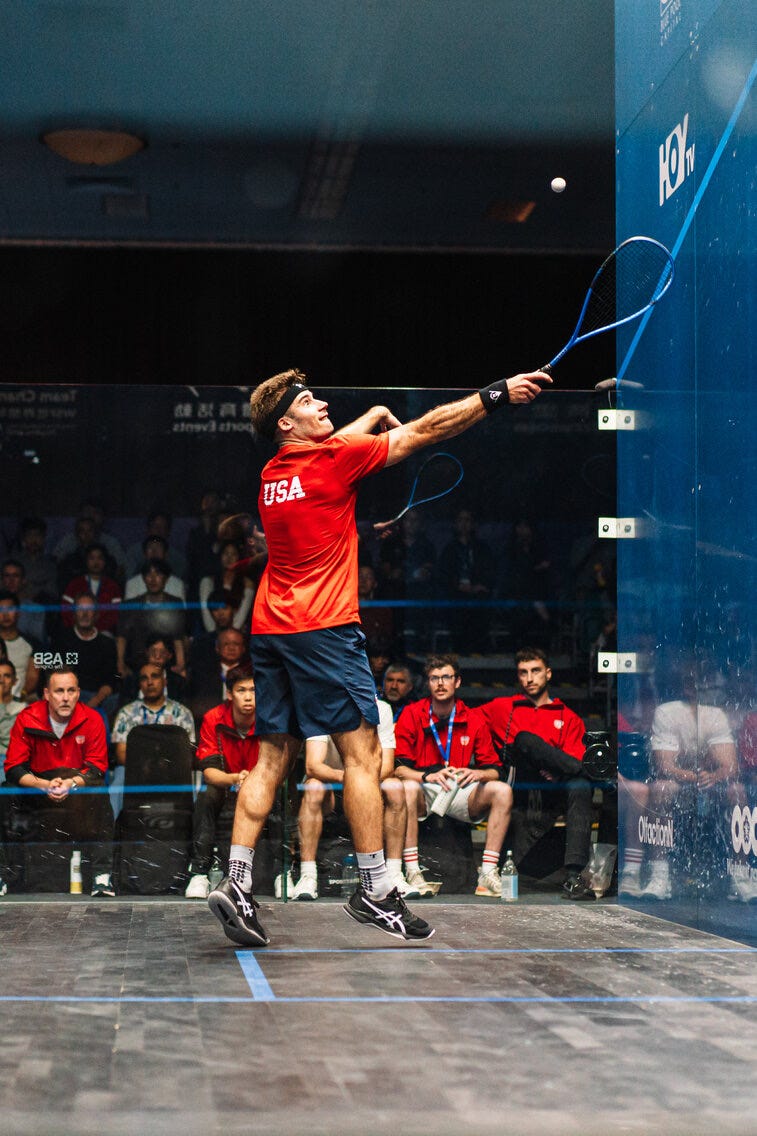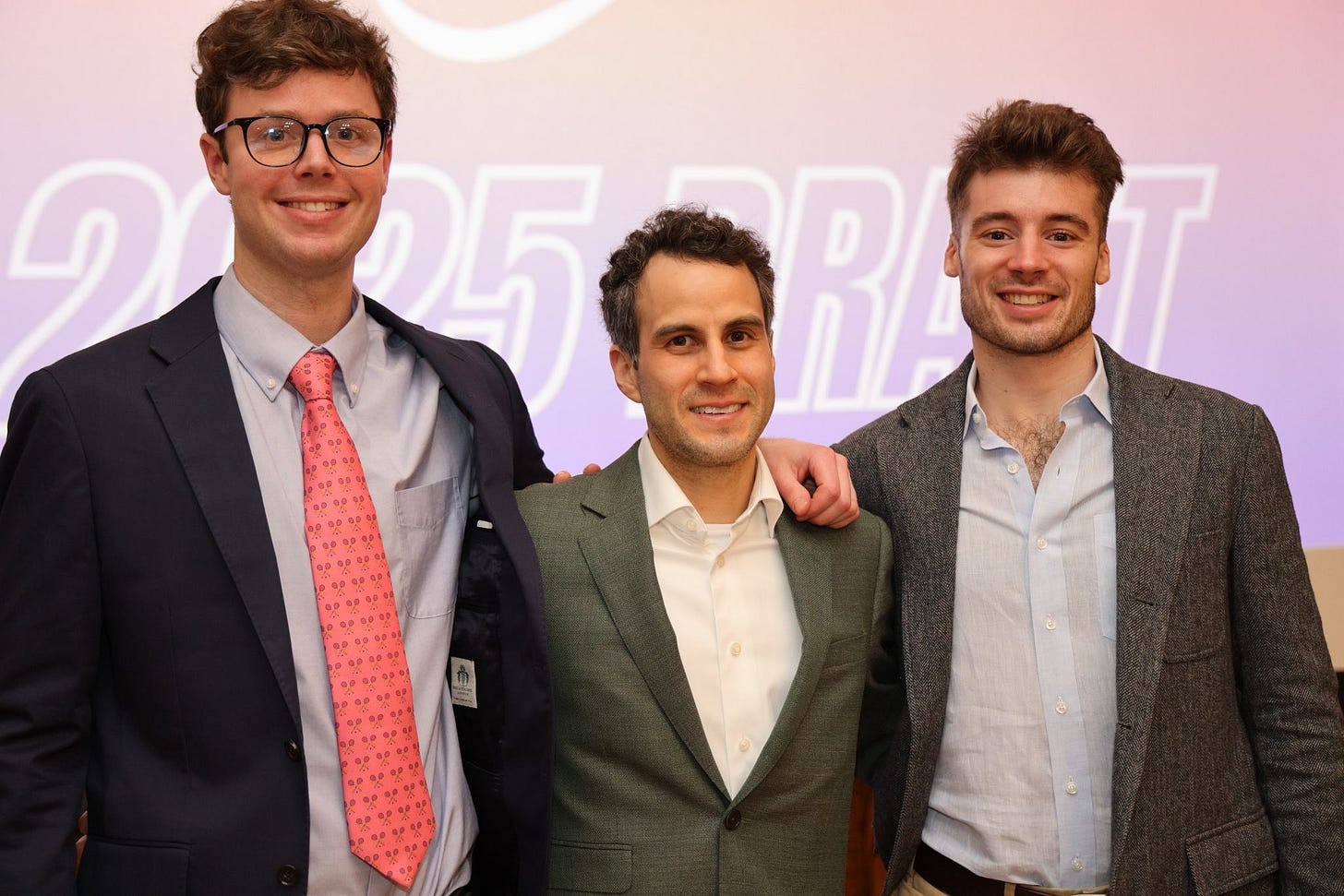The Man Changing The Way Squash Is Watched
Clubland USA sits down with Spencer Lovejoy
It’s impossible to play squash at the New Haven Lawn Club without hearing the name Spencer Lovejoy, who, at eight, crossed over from the light side—tennis courts—to the windowless basement dwellers that the squash players are. Almost two decades after he first picked up a squash racquet, Lovejoy, now 27, announced his retirement from the professional squash tour earlier this month to become the CEO of the National Squash League, having reached an all-time high world ranking of 64.
Clubland USA sat down with Lovejoy last week.
The National Squash League is one of those things you don’t really see very often in the squash world: revolutionary. When you walk onto a squash court, you’ve been removed from a sense of time and place: you’re stuck in time. The only thing that counts is the ball, your opponent, and you.
However, when Lovejoy was playing on the professional squash tour, he commonly encountered “people [who] used to ask me when I played pro, ‘What team do I play for?’” The very popularity of team sports in the United States, from football to hockey to basketball, causes spectators who have not already been initiated into the cult of squash to wonder where the camaraderie and the team-spirit is lurking.
It is not that team play is alien to the world of squash: college squash is centered around teams, and national teams are pitted against each other in the Pan-American Games, among other tournaments. League play is an important social glue for the squash world, for amateurs and professionals alike. European squash leagues with high-profile players have sprung up in Germany and the Netherlands, but league play has remained more or less alien to the world of American squash. There has not been anyone who has attempted to bring this stateside besides Lovejoy, Timmy Brownell, and Fernando Valdizan.
The National Squash League, however, also goes further format-wise than any of their European counterparts. NSL teams field three players a side, and games are divided into two twenty-minute segments and a final thirty-minute segment. Players can be substituted, and powerplays, when only the team who has called a powerplay can score, too, are novel additions to the way the sport is played. Bringing tools from other American sports—basketball and football—into the squash world can prove to be a truly potent tonic for the sleepy backwaters that professional squash can oftentimes be.
The National Squash League finished its first season in 2024, and the second in 2025. The first season featured six teams in two divisions, which rapidly expanded to nine men’s teams across three divisions and four women’s teams across two divisions by 2025. The winner of each division, along with a wildcard, advances to playoffs.
Clubland USA watched a second-season game between the Greenwich Panthers and the New York Knights at Open Squash in Lower Manhattan in May.
Did the NSL live up the part? In some ways, the sport was extremely fast-paced—not that squash is a slow game. The format guaranteed spectators at least seventy minutes of play, and the general level of play was admirable. Thankfully there was a bar, and most spectators were enthusiastic about it.
With the introduction of some of the pro tour’s best players, including Mostafa Asal, the infamous blocker and the world’s best player, and Juan Vargas, now 34 in the world, the National Squash League is gaining momentum with top-tier players. It helps that both Lovejoy and Brownell spent time on the pro tour and are first-class players: the squash tour is a small world of roving racquet sport fanatics.
The National Squash League began to take earnest form in the face of dangerous blocking during a PSA event, and, as Lovejoy himself observed, blocking and poor sportsmanship are rampant on the PSA.
The Canadian squash player and commentator Nicole Bunyan, who refereed the match Clubland USA was invited to see, was good at nipping blocking in the bud. However, as kismet has it, this time, it was Yow Ng, the Malaysian player who had the previous week been at the receiving end of one of Asal’s nastier blocks, who was blocking. Bunyan was decisive about preventing repeats, however, and kept the game moving along.
The idea for the National Squash League came to Lovejoy and the current #1 American squash player, Timmy Brownell. “One thing about playing the pro tour”, Lovejoy told me, was that “you have a lot of downtime … because you can really only train four or five hours a day, and then your body is just too fatigued”.
Lovejoy and Brownell met their third partner in the National Squash League, Fernando Valdizan, a personal injury lawyer in Louisville, KY, home to the Pendennis Club, when Brownell was being hosted by Valdizan for a Professional Squash Association [PSA] tournament four years ago.
“There were a couple of first-round matches in this tournament that were pretty gnarly”, Lovejoy recounted, including a match “where a player really over-exaggerated his swing, trying to block out the other player”, and landed up hitting the squash player Andrew Douglas, a friend of Lovejoy’s and Brownell’s.
Douglas “had to get stitches in his eye”, and the tournament reflected a pandemic of poor sportsmanship on the professional squash tour. “Sometimes playing the PSA tour brings out the worst in players, causing them to display bad sportsmanship”, Lovejoy remembers. “They have a ‘do anything to win’ mentality, and that causes them to make some bad decisions on the court.” Even the New York Times, usually oblivious to this sort of stuff, took note of the poor sportsmanship of the current world #1, the Egyptian squash player Mostafa Asal, who has long hit and blocked and kicked opponents on court.
“It was really just a bad situation for the club and the fans”, Lovejoy recounted. He remembers Valdizan remarking, “Well, that was a weird environment—isn’t squash meant to be fun to watch?” Dissatisfied with the viewing experience on the pro tour, Valdizan was left wondering whether there was something else out there in the squash world that would provide a better experience for spectators and players alike.
It was at this point that Lovejoy was roped in by Brownell, who he has known for the better part of a decade and a half, since they were juniors in the under-13 division. Lovejoy was enthusiastic at first; what had once been locker room talk, a pipe dream at best, now had the chance to turn into something real. Jumping at the opportunity to build something, Lovejoy told Brownell that the league “sound[ed] like a really good opportunity to change the trajectory of squash.”
“The goal has always really been to grow squash and to create something to help fans get into the sport”, Lovejoy told me. “That’s a little bit more approachable than a hardcore PSA match, and I think the PSA is great. I loved playing it for the 4 years that I played, but I don’t think the product is super approachable for the average sports fan sometimes. We’re hoping to create something that’s a little more fun …. It has that team aspect. It has that camaraderie. It has that city rivalry.”
I’ve always been suspicious of anything that promises to make something more accessible, even more so when it’s a sport I love (but don’t play terribly well). The National Squash League, however, has much to offer a sport that has remained confined to Clubland, much to its own detriment. Between squash’s inclusion in the 2028 Los Angeles Olympics, the Squash Educational Alliance’s various programmes, and now the National Squash League, I truly hope that squash doesn’t go the way of more arcane racquet sports—racquet tennis, squash tennis, and court or “real” tennis come to mind. The health of a sport requires new blood, and, sometimes, even the young fogeys have to countenance it. Lovejoy is it. —IJ


